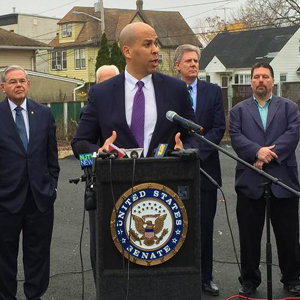How to Reduce Air Pollution

NEWARK, NJ – Today, U.S Senators Cory Booker and Bob Menendez (both D-NJ) renewed their call to hold polluters responsible for the cleanup of contaminated sites in New Jersey and across the country following the U.S. Environmental Protection Agency’s (EPA) release this week of a proposed plan to address groundwater contaminated with hexavalent chromium at the Garfield Groundwater Contamination Superfund site in Garfield, New Jersey.
“I am encouraged to hear that progress is being made at the Garfield Superfund site, but the fact remains the cost for the cleanup will fall with the EPA and in turn, the taxpayer,” said Sen. Booker, a member of the Senate Subcommittee that oversees the EPA’s Superfund program.
"In December I stood in Garfield with my colleagues to discuss our efforts to help get some of New Jersey’s most contaminated sites cleaned up and highlight the fact that it’s simply unacceptable for communities like this to languish in uncertainty while Congress fails to address the shortfalls in the Superfund cleanup program. That is why I introduced the Superfund Polluter Pays Restoration Act of 2015 which places the financial burden for cleaning up our nation’s most toxic sites back where it belongs: with the polluters.”
“The EPA’s plan to remediate the Garfield Superfund site and return the land back to the community is promising, but we must ensure the funding is available to complete the job,” said Sen. Menendez.
“Taxpayers should not have to bear the financial burden of cleaning up someone else’s toxic mess. The polluters should pay; it’s as simple as that. Companies that profit by polluting our environment must be held accountable and responsible for the cleanup. By passing the Superfund Polluter Pays Restoration Act of 2015, we will have the funding available to clean up New Jersey’s 114 Superfund sites, protect the health and safety of our residents, and create jobs and economic development in the process.”
The EPA is proposing a plan that will require a combination of cleanup measures to address the problem in the long term, including treatment of the contaminated groundwater with a non-hazardous additive that will reduce the contamination, and restrictions on the use of the groundwater. The EPA announced they will hold a public meeting on May 19 to explain the proposed plan for the Garfield site. Comments will be accepted until June 8.
In December, Sens. Booker and Menendez were joined by Congressmen Bill Pascrell, Jr. (NJ-09) and Frank Pallone, Jr. (NJ-06) at Garfield’s superfund site to announce the reintroduction of legislation in the Senate and House that would force industries responsible for contamination of Superfund sites to pay for their clean-up. The Superfund Polluter Pays Restoration Act of 2014 reinstates the excise tax on polluting industries to pay for the cleanup of Superfund sites, relieving taxpayers of the expense. It also expands the definition of crude oil in order to make oil from tar sands and shale subject to the excise tax. Additionally, it makes funds available to the Environmental Protection Agency (EPA) on an ongoing basis, not subject to annual appropriations.
In 2014, as the Chairman of the Oversight Subcommittee on the Senate Environment and Public Works Committee, Sen. Booker chaired a hearing on the need for increased funding for EPA's Superfund program. Then-Garfield Mayor and current Councilman Joseph Delaney testified at the hearing to discuss the urgent need for increased federal funding to cleanup Superfund sites in communities like Garfield.
Following the hearing, Sen. Booker and Senator Barbara Boxer (D-CA) requested a Government Accountability Office (GAO) report on the downward funding trend and its impact on the effectiveness of the program. The report, released in October, shows that while the number of Superfund sites increased between 1999 (1,054) and 2013 (1,158), funding for cleanups has continued to decline.
New Jersey has 114 Superfund sites on the National Priority List - more than any other state. These sites are the most heavily contaminated properties in the country, and are the areas that pose the greatest potential risk to public health and the environment. These sites are poisoning nearby residents, endangering the health of children, and thwarting economic development in communities across the country.
The Garfield Groundwater Contamination site consists of groundwater contamination from chromium originating from the E.C. Electroplating, Inc. property. EPA initiated removal action of tanks and soil contaminants in fall 2011 and it continued to May 2014. EPA has funding for the site through 2017, but not enough for remedial action to be completed.

